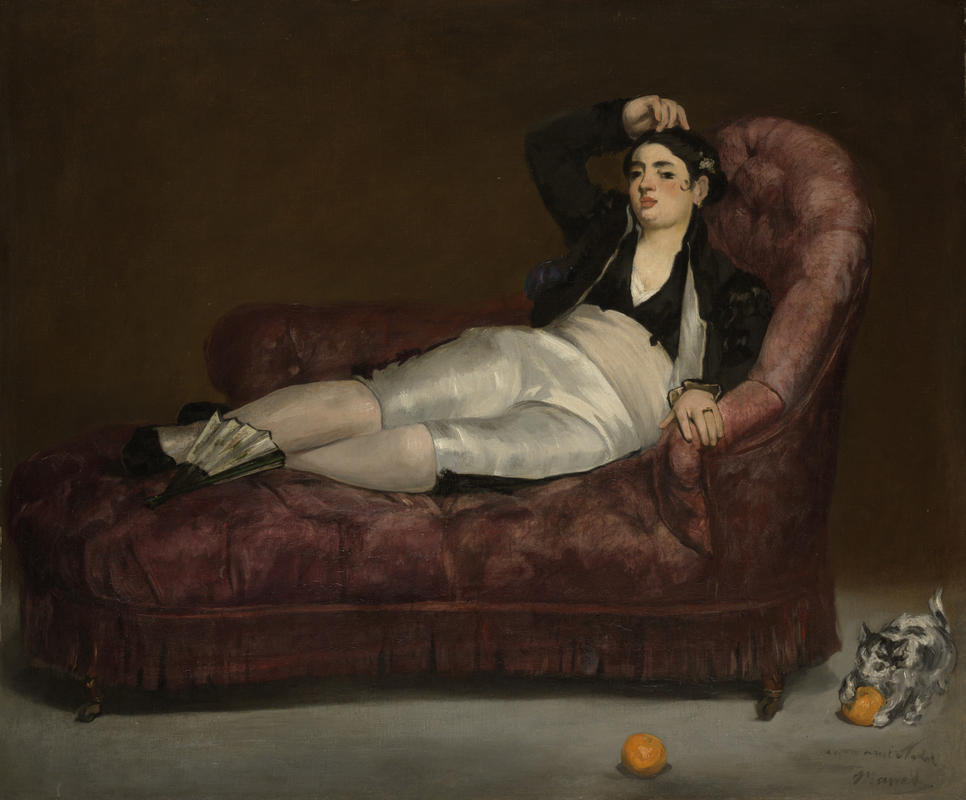More about Reclining Young Woman in Spanish Costume

Sr. Contributor
There are a lot of artists, especially from 19th century Western Europe, who regularly had their models dress up in “exotic” or otherwise foreign-looking costumes. Édouard Manet was no different.
Manet had both of his wives (at different times!) model in many different forms of dress. The model in Reclining Young Woman in Spanish Costume, however, is not his wife. No, it’s not his mistress, either...that would be just too juicy! However, based on circumstantial evidence, the woman dressed like a Spanish maiden is possibly the mistress of his friend “Nadar."
Nadar was a pseudonym for Gaspard-Félix Tournachon, a well-known French photographer, writer, and balloonist, among other things. Manet included an inscription, “To my friend Nadar,” on the corner of this painting, which is a decent clue. It’s probably safe to assume that this picture is not one that Nadar took home to his wife, but hung in whatever apartment he used for his hook-ups with the young woman pictured. During the same time period, Manet also painted another mistress, this one being that of the poet Charles Baudelaire, and just so there was no confusion, the painting was titled, Baudelaire's Mistress, Reclining, though it is also sometimes called the much more mundane Lady with a Fan.
Reclining Young Woman was painted during a period when Manet was fascinated with Spanish culture, including traditional Spanish dress; this is not entirely surprising as one of Manet’s influences was Francisco Goya. This painting was partially based off of Goya’s The Clothed Maja, as opposed to his Nude Maja, which, for some reason, proved to be the much more popular one of the two works. (A maja is, in this context, a female of the lower classes of Spanish society.) Manet would also later paint his younger brother, Gustave, as a Young Man in the Costume of a Majo, for the male version of this stereotype.
The interest in Spanish style dress may have first begun when a guitarist from Spain named Huerta, became the “rage of Paris” in the early 1860s; this musician was the inspiration for Manet's The Spanish Singer, at the Metropolitan Museum. Speaking of dress, the previously mentioned brother Gustave wore the same pants and bolero jacket in Majo, that were used by the model Victorine Meurent in another Manet work, Mademoiselle V… in the Costume of an Espada.
The woman and her pose in Reclining Young Woman have been compared to Manet’s most well-known work, Olympia; both paintings have a woman in a seductive, supine position on a couch. More importantly, they both have a cat in the corner of the painting. Cats have represented many things in the history of art, from paganism in the Middle Ages, to scholarship during the Renaissance, to domesticity and laziness in the Dutch art of the 17th century. However, in Manet’s time, within certain scenes like this one, the cat was known to symbolize femininity, sexuality, sensuousness, or just plain old lust. Seeing as how this was a depiction of someone’s mistress, the cat hanging out near the woman fits perfectly.
Sources
- Adler, Kathleen. Manet. Oxford: Phaidon, 1986.
- Bracquemond, Félix Henri. “Young Woman Reclining in Spanish Costume.” The Art Institute of Chicago. Prints and Drawings. https://www.artic.edu/artworks/159808/young-woman-reclining-in-spanish-….
- Covenantarthistory. The Cat: A Sensuous Symbol, April 25, 2015. http://covenantarthistory.blogspot.com/2015/04/the-cat-sensuous-symbol…
- Hanson, Sarah P. “Goddess, Hunter, Consort, Thief.” ARTnews.com. ARTnews.com, November 18, 2019. https://www.artnews.com/art-news/news/goddess-hunter-consort-thief-167/.
- Kessler, Marni Reva. "The Other Side of the Veil." In Sheer Presence: The Veil in Manet’s Paris, 94-141. University of Minnesota Press, 2006.
- Rey, Robert. Manet. Paris: Flammarion, 1983.
- Smee, Sebastian. “A Precursor to 'Olympia' Shows Edouard Manet Nearing the Peak of His Powers.” Boston.com. The Boston Globe, August 31, 2010. http://archive.boston.com/ae/theater_arts/articles/2010/08/31/a_precurs…
- “Young Man in the Costume of a Majo.” metmuseum.org. https://www.metmuseum.org/art/collection/search/438819.











